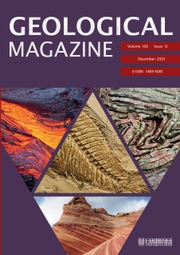Article contents
Cross-folds
Published online by Cambridge University Press: 01 May 2009
Abstract
Many recent investigators report the presence of “ cross-folds ” in mountain chains. The common right angle relations between such folds and the main trends suggest that they are genetically allied. Following the original suggestion of Argand, it is proposed that the superficial cross-folds are due to basement control (passive segmentation), whereas those in the deeper parts of geosynclines have been brought into being by the limitations of space (active segmentation).
- Type
- Articles
- Information
- Copyright
- Copyright © Cambridge University Press 1957
References
REFERENCES
Argand, E., 1912. Sur la Segmentation Tectonique des Alpes Occidentals. Bull. Soc. Vaud. Sc. Nat., xlviii, 5th Ser., 345–356.Google Scholar
Argand, E., 1915. Extrait de la Suisse liberale du 9 juin 1915 (Soc. Neuchat. Sc. Nat.), 1–3.Google Scholar
Bailey, E. B., and McCallien, W. J., 1937. Perthshire Tectonics: Schiehallion to Glen Lyon. Trans. Roy. Soc. Edinb., lix, 79–117.CrossRefGoogle Scholar
Bassett, D. A., 1955. The Silurian Rocks of the Talerddig District, Montgomeryshire. Quart. Journ. Geol. Soc., cxi, 239–264.CrossRefGoogle Scholar
Cross, W. H., 1955. Geological Implications of an Indirect Method of Mapping Regional Folds in Archean Rocks. Econ. Geol., 1, 321–332.Google Scholar
Cummings, W. A., and Shackleton, R. M., 1955. The Ben Lui Recumbent Syncline (S. W. Highlands). Geol. Mag., xcii, 353–363.CrossRefGoogle Scholar
Engel, A. E. J., 1949. Studies of Cleavage in the Meta-sedimentary Rocks of the Northwest Adirondack Mountains, New York. Trans. Amer. Geophys. Union, xxx, 767–784.Google Scholar
Fourmarier, F., 1953. Schistosité et Grande Tectonique. Ann. Soc. Géol. Belg., lxxvi, 275.Google Scholar
George, T. N., 1955. The Silurian Rocks of the Talerddig District, Montgomeryshire. (Discussion), Quart. Journ. Geol. Soc., cxi, 263–264.Google Scholar
Gilmour, P., and McIntyre, D. B., 1954. The Geometry of the Ben Lui Fold (Scottish Highlands). Geol. Mag., xci, 161–166.CrossRefGoogle Scholar
Hungurer, E., 1922. Ein Belegstück zur Elastizitätstheorie der Faltung. Zent. Miner, 105.Google Scholar
King, B. C., 1955. The Tectonic Pattern of the Lewisian around Clashnessie Bay, near Stoer, Sutherland. Geol. Mag., xcii, 69–80.CrossRefGoogle Scholar
King, B. C., and Rast, N., 1955. Tectonic styles in the Dalradian and Moines of parts of the Central Highlands of Scotland. Proc. Geol. Ass., lxvi, 243–266.Google Scholar
King, B. C., and Rast, N., 1956. The Small-scale Structures of South-eastern Cowal, Argyllshire. Geol. Mag., xciii, 185–195.CrossRefGoogle Scholar
Koenigsberger, J. G., 1924. Das experimentelle Studium das Faltungs-vorgänge. Naturwiss, xii, 568.CrossRefGoogle Scholar
McIntyre, D. B., 1952. The Tectonics of the Beinn Dronaig Area, Attadale. Trans. Edin. Geol. Soc., xv, 258–264.CrossRefGoogle Scholar
Rast, N., 1955. Tectonics of Central Perthshire. Unpublished thesis (University of Glasgow).Google Scholar
Reynolds, D. L., and Holmes, A., 1954. The Superposition of Caledonoid Folds on an Older Fold-System in the Dalradians of Malin Head Co. Donegal. Geol. Mag., xci, 417–444.CrossRefGoogle Scholar
Sitter, L. U. de, 1952. Plissement croisé dans le Haut Atlas. Geol. en Mijnbouw, xiv, 277–282.Google Scholar
Sutton, J., and Watson, J., 1954. The Structure and Stratigraphical Succession of the Moines of Fannich and Strath Bran, Ross-shire. Quart. Journ. Geol. Soc., cx, 21–54.CrossRefGoogle Scholar
- 22
- Cited by


